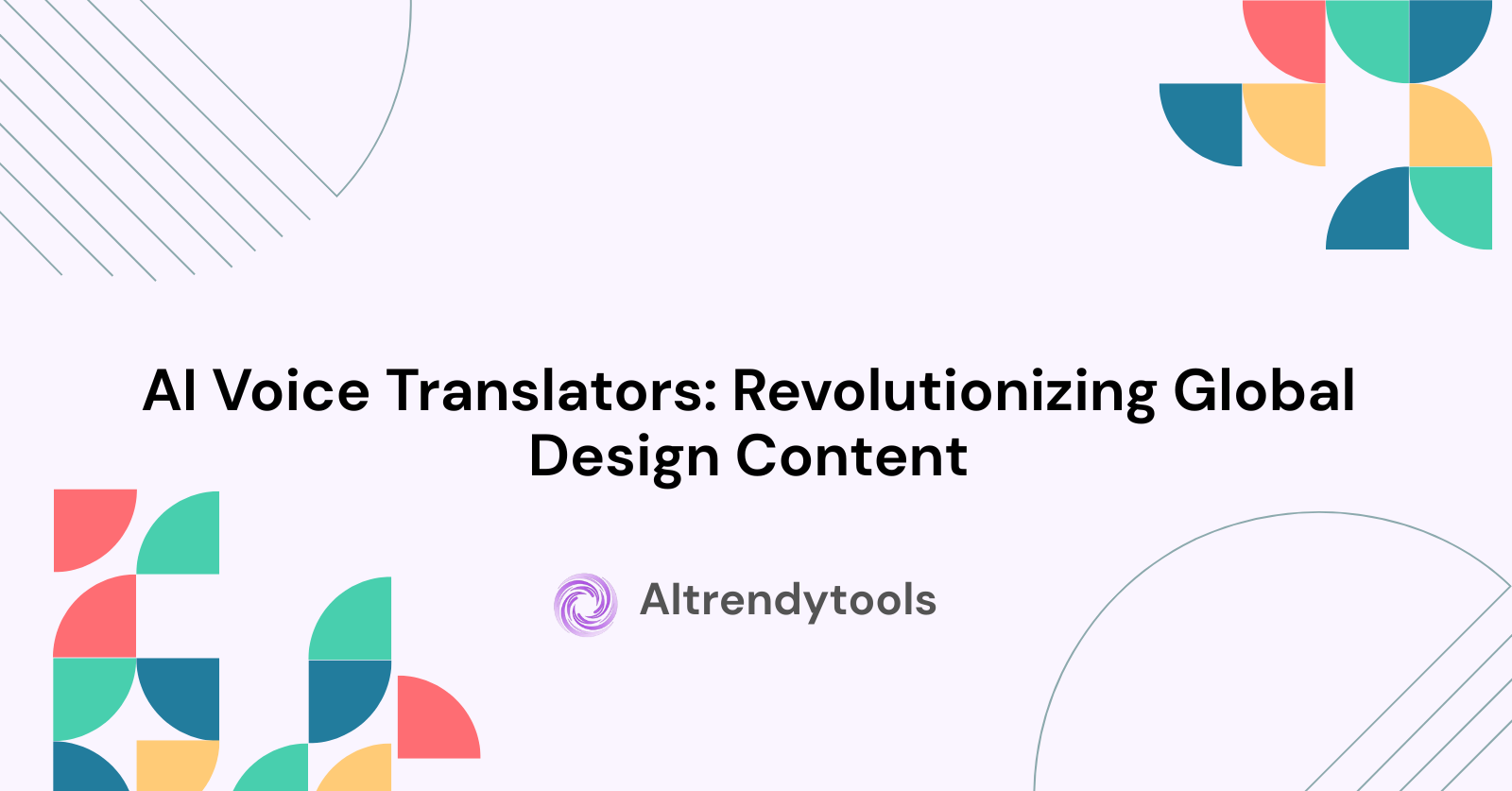🔥 AITrendytools: The Fastest-Growing AI Platform |
Write for usAI Voice Translators: Revolutionizing Global Design Content
Discover how AI voice translators transform multilingual content creation, helping designers and creatives reach global audiences with fewer resources.
Aug 26, 2025
In today’s fast-paced digital world, the demand for accessible, inclusive, and multilingual content has never been higher. As the internet becomes more global, creatives and designers are being pushed to produce content that resonates across different languages, cultures, and regions. Enter AI voice translators – a groundbreaking technology reshaping how content is created, shared, and experienced globally.
What Are AI Voice Translators?
AI voice translator is an advanced tool powered by artificial intelligence that converts spoken words from one language into another in real-time or via recordings. It leverages deep learning, natural language processing (NLP), and speech recognition technologies to deliver accurate and contextually appropriate translations. Unlike traditional text-based translators, AI voice translators can replicate tone, emotion, and even vocal nuances, making them invaluable for designers and creatives who work with multimedia content.
The Growing Need for Multilingual Content
Globalization has brought people closer, but language remains a major barrier. For designers, videographers, game developers, animators, and other creatives, the ability to produce content in multiple languages is crucial for reaching broader audiences. Whether it's an animated explainer video, a podcast, a virtual reality experience, or an interactive app, multilingual content increases accessibility, engagement, and cultural relevance.
In this context, AI voice translators are not just tools but enablers of creativity and innovation. Here’s how they are transforming the landscape for designers and creatives:
1. Breaking Language Barriers in Real Time
Real-time AI voice translation is a game-changer for creatives collaborating across borders. Imagine a Japanese game designer and a French sound engineer brainstorming in their native languages while understanding each other perfectly. AI-powered tools like Google Translate, Microsoft Azure Translator, and newer platforms like DeepL and Meta's SeamlessM4T enable seamless communication and ideation.
Designers can now attend global design sprints, workshops, or virtual conferences without worrying about linguistic limitations. This opens up new opportunities for learning, networking, and collaboration.
2. Enhancing Voiceover and Dubbing Workflows
Voiceovers are critical to videos, tutorials, animations, and games. Traditionally, dubbing a video into multiple languages required hiring native speakers, scheduling studio time, and spending on post-production editing. AI voice translators drastically reduce this overhead.
Tools like ElevenLabs, Resemble.ai, and Murf.ai can clone voices and translate scripts into different languages while maintaining the speaker’s original tone and emotional expression. These text to speech tools are especially valuable for creatives because they enable:
- Faster turnaround times
- Lower production costs
- Consistent voice quality across languages
- Ability to scale content internationally without needing massive resources
3. Improving Accessibility and Inclusivity
One of the most significant advantages of AI voice translation is improved accessibility. Designers can now create content that serves people with different linguistic backgrounds, disabilities, or learning needs. This includes creating multilingual educational content about essential services - from healthcare information to resources that help individuals advocate for social security disability benefits in their native language. For example:
- Educational videos can be translated and dubbed into multiple languages for global learners.
- Audiobooks and podcasts can be made available to non-native speakers or hearing-impaired speakers using AI-generated subtitles and voiceovers.
- UX designers can build multilingual voice interfaces for smart apps and devices.
This level of inclusivity broadens audience reach and promotes diversity in content consumption.
4. Fueling Creative Storytelling and Immersive Experiences
Designers and creatives are always looking for new ways to tell stories. With AI voice translators, they can create more immersive and interactive narratives that adapt to different cultural contexts. Imagine a video game where characters speak to the player in their native language with accurate voice inflection or an AR/VR tour guide that speaks dozens of languages based on user preference.
This customization elevates user experience and makes content feel more personal, authentic, and engaging. It also allows creators to explore cross-cultural storytelling without losing the essence of their original message. For more enhanced storytelling experiences, AI voiceover for presentations can further enhance this impact, making slides and pitches more dynamic and accessible to diverse audiences.
5. Accelerating Global Marketing Campaigns
Speed and accuracy are essential for creative teams working in advertising and branding. AI voice translators allow marketers to launch campaigns in multiple languages simultaneously. Instead of waiting weeks for human translation and voiceover, campaigns can instantly be adapted for various markets.
This gives brands a competitive edge in responding to trends, launching products globally, and maintaining consistent messaging across geographies. Tools like Descript, Synthesia, and Papercup are already helping marketing teams achieve this with AI-driven multilingual video creation.
6. Empowering Independent Creators and Small Studios
Traditionally, creating multilingual content required significant financial resources – a barrier for independent artists and small creative agencies. AI voice translation levels the playing field. Now, a solo YouTuber, indie game developer, or freelance designer can:
- Translate and dub their content into several languages
- Reach international audiences
- Monetize content globally
This democratization of technology empowers more voices to be heard and stories to be shared across borders.
Challenges and Ethical Considerations
While AI voice translators offer immense potential, they also come with challenges:
- Accuracy: Not all translations are perfect, especially with slang, idioms, or cultural references.
- Voice cloning ethics: Using someone’s voice without consent raises privacy and copyright issues.
- Bias in AI models: Some languages and dialects are underrepresented, leading to biased outputs.
- Job displacement: Concerns about AI replacing human voice actors and translators persist.
To address these, creators must use AI tools responsibly, prioritize transparency, and combine AI capabilities with human oversight when necessary.
The Future of AI Voice Translation in Creative Industries
As AI voice translators evolve, the future looks promising for content creators. Advances in generative AI, emotional speech synthesis, and contextual translation will make outputs more human-like and culturally aware.
We can expect:
- More natural, emotive AI-generated voices
- Tools integrated directly into creative software like Adobe Creative Cloud
- Multimodal translation (combining voice, text, image, and gesture)
- Real-time multilingual streaming for virtual events and metaverse experiences
These innovations will allow creatives to push boundaries and connect with audiences in previously impossible ways.
Final Thoughts
AI voice translators are not just technological novelties but catalysts for a new era of global content creation. For designers and creatives, they offer a powerful means to break language barriers, amplify storytelling, and scale their work worldwide.
As with any tool, the key lies in thoughtful integration. Combining human creativity with AI efficiency can make the creative world more inclusive, impactful, and universally understood.
🚀 Submit Your Tool to Our Comprehensive AI Tools Directory
Get your AI tool featured on our complete directory at AITrendytools and reach thousands of potential users. Select the plan that best fits your needs.





Join 30,000+ Co-Founders
Related Blogs
MBR vs GPT: 7 Key Differences You Must Know (2025)
Discover the critical differences between MBR and GPT partition styles. Learn which one suits your system, size limits, compatibility, and conversion methods.
Ask Writer AI Review 2025: Features, Pricing & Alternatives
Honest Ask Writer AI review based on hands-on testing. Compare features, pricing, and alternatives to find the best AI writing assistant for your needs.
Quetext Plagiarism Checker Review 2025: Features & Pricing
In-depth Quetext review covering DeepSearch technology, pricing plans, accuracy testing, and better alternatives for students and content creators.
Submit Your Tool to Our Comprehensive AI Tools Directory
List your AI tool on AItrendytools and reach a growing audience of AI users and founders. Boost visibility and showcase your innovation in a curated directory of 30,000+ AI apps.





Join 30,000+ Co-Founders

